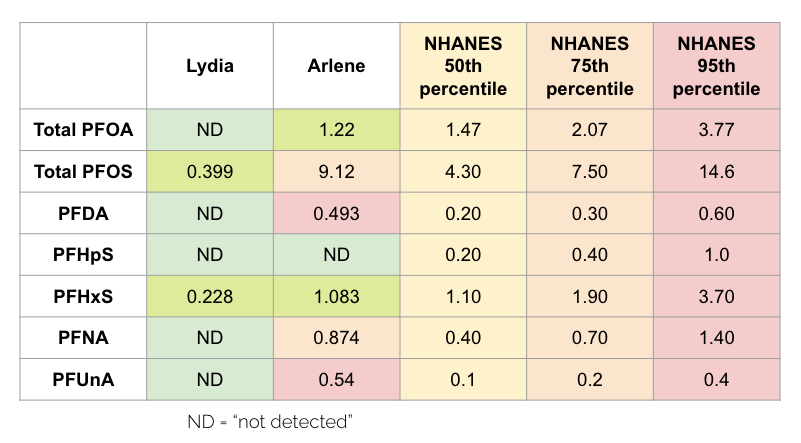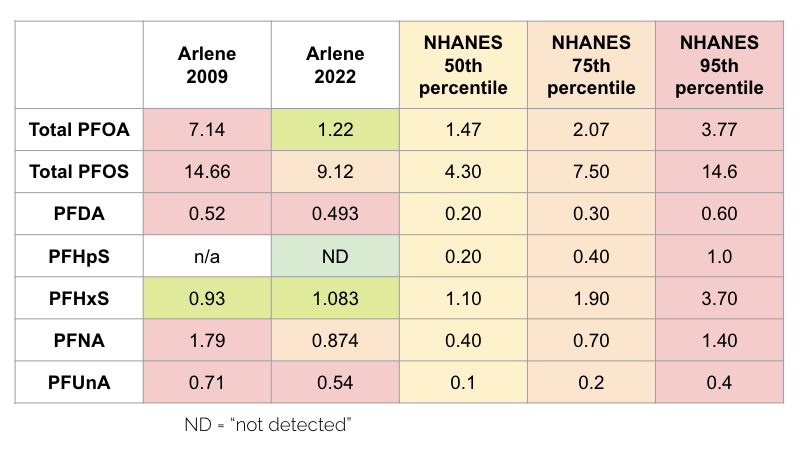Our PFAS Blood Test Results
By Lydia Jahl | September 14, 2022
Followers of Green Science Policy Institute know that per- and polyfluoroalkyl substances, or PFAS, are harmful “forever chemicals” that should be avoided at all costs. But, you also may know that essentially every person tested in the United States has detectable concentrations of PFAS due to their widespread use and resistance to degradation. In the past, PFAS testing to learn about your own exposure could only be accomplished through specific research projects or biomonitoring programs that required expensive blood draws. However, recent advances in analytical chemistry have led to the development of Eurofins’ at-home PFAS Exposure Blood Test.
Arlene and I had the chance to complete this easy kit that only required online registration, a quick finger prick from the comfort of our office, and a few weeks wait before getting the results of our blood levels of 47 different PFAS. See below for a comparison of our values to the 2017-2018 National Health and Nutrition Examination Survey (NHANES) dataset (note that our values are capillary blood measurements while NHANES values are serum levels, so the values may not be directly comparable). The test kit also provided results for many more PFAS not usually tested for in NHANES or other surveys, but we both had levels below the reporting limits for the remaining chemicals.

Arlene’s Results
As expected, Arlene’s concentrations were higher than mine. PFAS can be excreted from the body, particularly during menstruation and lactation, which results in the observed trends that females in their late teens to early 40’s have lower serum PFAS levels. Arlene does have reduced PFAS levels in her body now compared to 13 years ago, when she participated in a research project that measured her PFAS levels – see the drastic decreases in her PFOA, PFOS, and PFNA below. These decreases are likely due to greatly decreased PFOA and PFOS use after their voluntary phase-out in the United States in 2015, or possibly due to the fact that more time has passed since Arlene spent her time climbing mountains, celebrating at the peaks by eating canned oysters and clams that can be highly contaminated with PFAS. Many PFAS have half-lives in the human body on the order of several years, so Arlene’s exposures from still impact her current levels. Today, Arlene supports companies that make PFAS-free outdoor gear and enjoys cross-country skiing in her PFAS-free Black Diamond jacket.

Lydia’s Results
I was very relieved to only have two PFAS above detection limits, despite having grown up in New Jersey, known for its widespread PFAS contamination due to industrial activities. I am grateful that my parents knew to filter our drinking water and use stainless steel pans instead of non-stick cookware, but it is possible my levels would be even lower if I grew up in a more remote area (although PFAS can travel throughout the globe, as demonstrated in a recent paper that showed levels of PFAS in rainwater that exceeded the latest EPA health advisory values, even in Antarctica!).
A likely reason that my PFAS levels are low is that I stopped eating all animal products over 6 years ago, for my own health (including reduced exposure to pollutants like phthalates), a reduced climate impact, and ethical reasons. In the general population, diet and drinking water are main sources of PFAS exposure, and fish, meat, & dairy tend to have high PFAS concentrations. A small German study found that vegans had lower levels of PFOS and PFNA than omnivores, and that the longer a person adhered to a plant-based diet, the lower their PFAS levels were. A local study of pregnant women in San Francisco found that women who ate the most dairy products had higher concentrations of PFNA and PFDA, while fish, poultry, & red meat consumption was associated with higher levels of PFOS, PFNA, PFUnA, and PFDA. No matter what you eat, PFAS can still be found in some food packaging, though to a lesser extent than when Green Science Policy Institute and our collaborators looked years ago.
What to do?
Thanks to the efforts of hundreds of scientists, policymakers, advocates, and more around the world, more companies are realizing the importance of removing PFAS from their products, and more legislation is being signed into law to help protect us. However, there are still actions you can take to limit your exposure to PFAS. For example, seek out alternatives to products that commonly contain PFAS, such as outdoor gear, cosmetics, and foodware. Levels of long-chain PFAS are especially high in animal-based foods, so switching to eating more plant-based foods may help reduce your PFAS exposure while also reducing your climate impact. The packaging of processed food can contain PFAS and other members of the Six Classes, so try to purchase fresh, minimally packaged foods as much as possible.
If you are concerned about your water quality due to living near airports, military facilities, or manufacturing sites that use PFAS, you can filter your drinking water. New carpets in the United States no longer contain PFAS, but after-market stain-resistant treatments still may contain PFAS, so be sure to check labels before spraying your carpets, boots, or clothing with water- and stain-resistant sprays. Write to your elected officials and tell them you want protection from PFAS, and after contacting them, make sure your favorite apparel brands and fast-food restaurants also know that you want their products to be PFAS-free.
For community members of contaminated areas or those at risk from occupational exposure, the National Academies of Sciences, Engineering, and Medicine recently published a report with recommendations on testing and clinical follow-up. They also note that bottled water can be contaminated with PFAS, that reduction of dust in your home may reduce your PFAS exposure, and that there is not enough evidence to know whether or not the use of non-stick pans and floss containing PFAS increases your exposure. At Green Science Policy Institute, we support the cessation of all non-essential PFAS uses because of the potential for harmful impacts of PFAS throughout their lifecycle, from the manufacturing to end-of-life disposal of products.